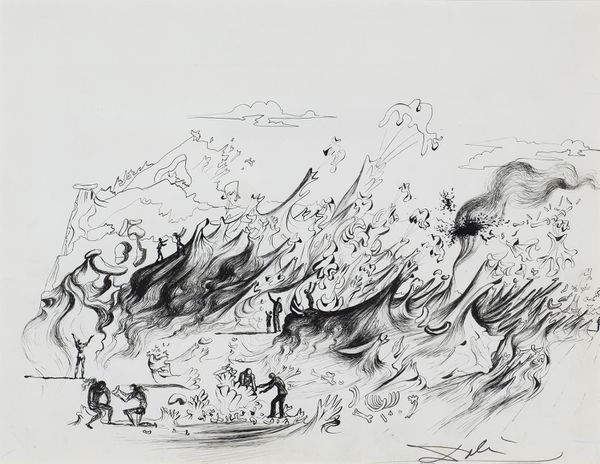Salvador Dalí
(Spanish, 1905-1989)
Dalí was born in 1904 in the town of Figueres, close to the French border in Catalonia, Spain. As a boy, he received formal training at drawing school and in 1917 his father organized an exhibition of his charcoal drawings in their family home. Dalí went on to have his first public exhibition in Figueres in 1919.
In 1922 at the age of 18 Dalí moved into the Residencia de estudiantes (Students' Residence) in Madrid to study at the San Fernando School of Fine Arts. At this stage, he already drew attention to himself as an eccentric, wearing long hair and sideburns, coat, stockings and knee breeches in the fashion style of a century earlier. But it was his experimental Cubist paintings which earned him the most attention from his fellow students. In these earliest Cubist works, he probably did not completely understand the movement, since he had very little information on Cubism other than a few magazine articles and a catalogue.
Dalí was expelled from the academy in 1926 shortly before his final exams, when he stated that no one on the faculty was competent enough to examine him. That same year he made his first visit to Paris where he met with Pablo Picasso, whom young Dalí revered; Picasso had already heard favourable things about Dalí from Joan Miró. Over the next few years, Dalí produced a number of works heavily influenced by Picasso and Miró as he moved toward developing his own style.
Throughout his life, Dalí devoured influences of all styles of art he could find and produced works ranging from the most academically classic to the most cutting-edge avant-garde. After passing through phases of Cubism, Futurism and Metaphysical painting, he joined the Surrealists in 1929 and his talent for self-publicity rapidly made him the most famous representative of the movement. His paintings employed a meticulous academic technique that was contradicted by the unreal `dream' space he depicted and by the strangely hallucinatory characters of his imagery. He described his pictures as `hand-painted dream photographs' and had certain favourite and recurring images, such as the human figure with half-open drawers protruding from it, burning giraffes, and watches bent and flowing as if made from melting wax.
In 1934 Dalí married his long term lover Gala and in 1937 they visited Italy together which was to have a profound effect on his artistic style. Dalí developed a new, more traditional style of painting, which together with his support of the new regime under Franco in the aftermath of the Spanish Civil War, put him at odds with his Marxist surrealist fellows over both art and politics. Eventually these differences led to Dalí's expulsion from the Surrealists ranks, and the surrealists henceforth spoke of Dalí in the past tense, as if he were dead.
In 1940, as World War II started in Europe, Dalí and Gala moved to the United States, during which time he devoted himself largely to self-publicity. He published his autobiography in 1942. During his years in the United States, Dalí's paintings were often on religious themes although sexual subjects and pictures centering on his wife Gala were also continuing preoccupations.
In 1955 Dalí and Gala returned to Spain. As Dali moved into a new stage in his career, he began experimenting with many unusual media and processes other than painting. Dalí's output included sculpture, book illustration, jewellery design, and work for the theatre. In collaboration with the director Luis Buñuel he also made the first Surrealist films. He also wrote a novel, Hidden Faces (1944) and several volumes of flamboyant autobiography.
In 1982, Dalí's wife Gala died. After Gala's death, Dalí lost much of his will to live. He deliberately dehydrated himself - possibly as a suicide attempt, possibly in an attempt to put himself into a state of suspended animation. He died of heart failure in 1989 at the age of 84, and is buried in the crypt of his Teatro Museo in Figueres. Although he is undoubtedly one of the most famous artists of the 20th century, his status remains controversial and many of his critics consider that he did little if anything of consequence after his classic Surrealist works of the 1930s.

